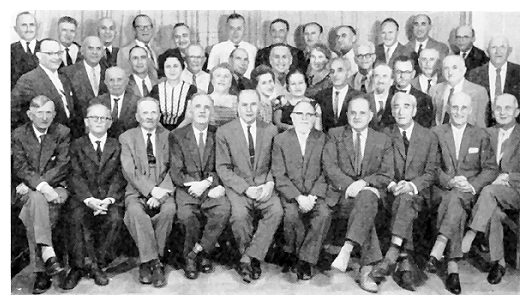Jewish Telegraphic Agency • April 24, 1944
Die Stimme • March 2005
Wikipedia • Romanian Edition

The Elias Weinstein Petition File (Courtesy: Peter Elbau, Israel State Archives)

First row sitting (f.r.t.l.): Teacher Jakob Melzer, Dr. Maximilian Weinberger, Dr. Zwi Brender, Dr. Josef Mann, Abraham Bojar – vice mayor of the town of Tel Aviv, Dr. Ben Zion Sternberg, Dr. Elias Weinstein, Mosche Liquornik, Dr. Erich Neuborn, Heinrich Deligdisch
Second row (f.r.t.l.): Jakob Stenzler, Prof. Moshe Weisinger, Zwi Neumeier, Dr. Theodor Blum, Solomon Preschel, Schlomo Erbsenthal, Dr. Pinchas Rosen, Regina Levi, Dr. Lucie Hecht-Preminger, Ascher Hofer, Ruth Schorr, Dawid Weiner, Regina Schneider, Regina Beer, Solomon Rosenberg, Dr. Heinrich Rubel, Isak Rosan, Eng. Gary Osterer
Third row (f.r.t.l.): Dr. Aron Hechtlinger, Leon Kraft, Nathan Ellenbogen, Mendel Stein, Jizchak Brückel, Dr. J. Feiger, Dr. Israel Drimmer, Dr. Josef Mosberg, Dr. Jizchak Pasternak, Dr. Karl Schorr, Jacob Spiegler, Markus Geller
Bukovinians in Israel (Courtesy: Peter Elbau, JewishGen)
The Har Zion could take 110 passengers.
(Israel’s National Maritime Museum)
The boat was sunk in 1940.
Ferry boat brings Har Zion passengers into Tel Aviv port.
The ship is identified in the caption as a “Jewish Agency ship”.
Har Zion passengers arrive in Tel Aviv.
http://www.israeldailypicture.com/: The Har Zion (built in 1907) and its sister ship Har Carmel were owned by the Palestine Maritime Lloyd shipping company, formed in 1934. The company and its ships were Jewish owned and operated under these principles:
1) Management according to business and professional basis.
2) Company to involve itself in the process of the building of the country
3) Company must be owned by Jewish interests
4) Ships will be under “Hebrew” flag
5) Crews will be Jewish
6) Ships will be supplied by local products
The Har Zion was mobilized by the British navy at the outbreak of World War II. In August 1940, on a voyage between England and Nova Scotia it was sunk by a German U-boat. Thirty-seven crewmen perished, including 17 Jews.
At the turn of the year 1932, Henry Ludwig Mond, 2nd Baron Melchett, pays a visit to Czernowitz, accompanied by his secretary, a son of the famous poet and Zionist politician Berthold Feiwel.
Henry Ludwig Mond, 2nd Baron Melchett, 10.05.1898 – 22.01.1949, was a British politician, industrialist and financier. Henry Mond was born in London, the only son of Alfred Moritz Mond, 1st Baron Melchett, and his wife Violet. He first visited Palestine in 1921 with Chaim Weizmann and subsequently became an enthusiastic Zionist, contributing money to the Jewish Colonization Corporation for Palestine and writing for Zionist publications. He became President of the British Zionist Foundation and made financial contributions to Zionist causes. He was the first President of the Technion in 1925. Melchett founded the town of Tel Mond, now in Israel.
Henry Mond With His Father and Two Sons
Statue of Lord Melchett in Tel Mond
He was educated at Winchester College. From 1915 he served in World War I with the South Wales Borderers but was wounded in 1916. He then joined some of his father’s businesses, becoming a director, and from 1940 to 1947 chairman, of Imperial Chemical Industries and he was also a director of the Mond Nickel Company and Barclays Bank. He served as Member of Parliament for the Isle of Ely 1923-24 as a Liberal. He then became a Conservative and was Member of Parliament for Liverpool East Toxteth from 1929 to 1931. On the death of his father in 1930 he succeeded to the barony becoming the 2nd Baron Melchett. He then set about restoring the family finances and moved his interests away from politics to economics.
Having been brought up in the Church of England, he reverted to his family’s Judaism in the 1930s and became a champion of Zionism, hoping that the Jews and Arabs could live harmoniously with each other. He advocated the evacuation of Jews from Germany to Palestine and supported the formation of an independent state of Palestine as part of the British Commonwealth. He was chairman of the British Agency for Palestine and took an interest in the Maccabean Jewish youth organisation. He married Amy Gwen Wilson, from South Africa, in 1920. She was described as: “a show stopping beauty and artist”.
They had a London home, Mulberry House in Smith Square, Westminster, which had a work of art by the era’s proment artist Charles Sargeant Jagger on display in their living room. This revealed a sensational secret that led to censure and outrage. They indulged in a ménage à trois with writer Gilbert Cannan, a friend of D H Lawrence. Paying homage to their sexual proclivities, they commissioned a 1.6m high relief from Jagger called “Scandal”. This showed a naked couple in an intimate embrace watched by society ladies in a state of outrage. The work was bought by the Victoria and Albert Museum for £106,000 where it is on display.
Mulberry House – Lord & Lady Melchett’s London Residence
They had had two sons and one daughter. The elder son, Derek, was killed in a flying accident while he was serving with the Royal Naval Volunteer Reserve in 1945. Mond bought and restored Colworth House on the edge of the Bedfordshire village of Sharnbrook and lived there for twelve years. During World War II he made the house available for the recuperation of American nurses and to house Jewish refugees.
Colworth House
He sold the house to Unilever in 1947 due to his wife’s conviction that moving to Florida would restore his health. He died at Miami Beach, Florida in 1949 and the title passed to his surviving son Julian.
Released by Edgar Hauster, based on Eric Turner’s article for the APOLLO MAGAZINE, dated 22.09.1009, published by The Esoteric Curiosa.